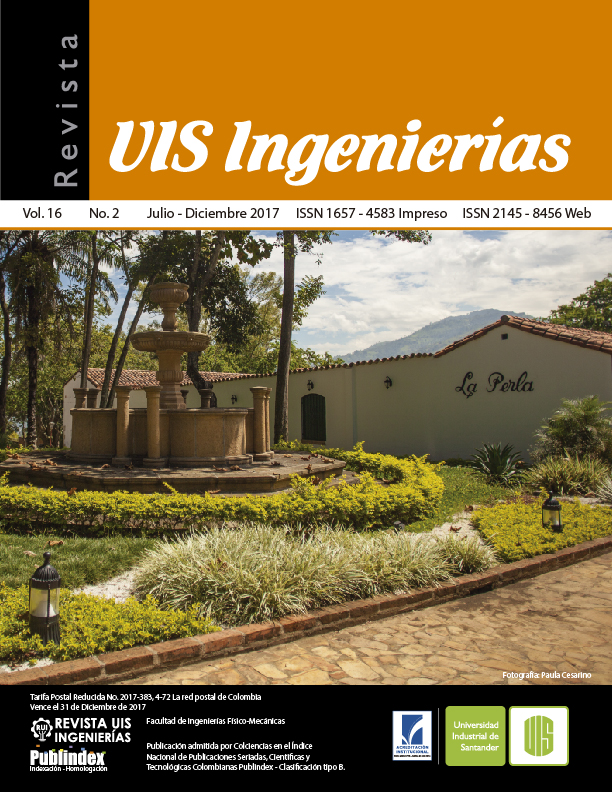Development of a knee prosthesis for transfemoral amputations using computational tools
Published 2017-06-30
Keywords
- knee prosthesis,
- transfemoral amputation,
- finite element method,
- CAD/CAM/CAE
How to Cite
Abstract
The present investigation is based on the analysis of the human walk, based on the movement of the knee joint to obtain the main parameters, with this data is developed with a mono-centric joint with reference to the characteristics of a patient, A This mechanism perform static analysis by computer, to determine the safety factor, with these data are processed to the simulation of the manufacture of such knee joint. A 3D knee prosthesis is developed from design to manufacturing, this makes 80% of the total time based on the design, analysis and simulation of manufacturing, leaving only 20% to manufacture, And greatly reducing errors and production times since these generate high costs.
Downloads
References
- Alva, M. F. (2011). Las personas con
- discapacidad en América Latina: del
- reconocimiento jurídico a la desigualdad real.
- Santiago de Chile: CEPAL Naciones Unidas.
- CONADIS, “Plan Nacional para el Buen Vivir
- -2017, Quito: República del Ecuador,
- consejo Nacional de Planificción, 2013”
- Claudia, P. M. (2008). Biomecánica clínica de
- la Rodilla. Universidad del Rosario, Facultad de
- Rehabilitación y Desarrollo Humano.
- Chien, H. (2014). Development of dynamic
- models of the Mauch prosthetic knee for
- prospective gait simulation. Jaurnal of
- Biomechanics.
- Espinoza, M. (2013). Niveles de amputación en
- extremidades inferiores. Repercusión en el
- futuro del paciente. Medicina física y
- rehabilitación.
- Huston, R. (2009). Principes of Biomecanics.
- Taylor & Francis.
- L. Robert, W. (2016). Engineering
- Biomechanics.
- Michael, Modern prosthetic knee mechanisms,
- (Margareta Nordin, 2004)
- Desarrollo de una prótesis de rodilla para amputaciones transfemorales usando herramientas 32
- computacionales
- Kapandji, A. (2006). Fisiología Articular. Paris:
- Médica Panamericana.
- Whittle, M. (2007). Gait Analysis. Siobhan
- Campbell.
- V. Streifeneder, V. S. (mayo de 2015).
- streifeneder. Obtenido de
- www.streifeneder.com
- Vertex
- D. Lema. (2013). Comparación estadística de
- medidas antropométricas entre mestizos,
- indigenas, y afro-ecuatorianos de la región sierra
- del Ecuador. Quito.
- Huston, R. (2009). Principes of Biomecanics.
- Taylor & Francis.
- Fuente:
- http://www.zonadiet.com/tablas/pesoideal.cgi
- [Recuperado el 12/11/2016]
- F. Valencia, X. Lima, D. Ojeda y D. Ortiz,
- “Prótesis de rodilla externa mecatrónica”,
- Biomecánica, vol. In Press, 2017
- .
- D. Ortiz, D. Zurita, A. Proaño y D. Ojeda, “Knee
- prosthesis controlled by electromyographic
- signal”, VI International Conference on
- Coupled Problems in Science and Engineering
- (ECCOMAS), San Servolo, Italy, 2015.
- D. Ortiz, D. Zurita, A. Proaño y D. Ojeda,
- “Articulación de rodilla para prótesis de pierna”,
- Avances en Ingeniería Biomédica y Visión a
- Futuro (Congreso I+D+Ingeniería), Cuenca,
- Ecuador, 2014.
- D. Ojeda, B. Gámez, Y. Azuaje y L. Zambrano,
- “Articulación de rodilla para prótesis de pierna”,
- VI Congreso Internacional de Métodos
- Numéricos, Morelia, México, 2013.
- M. Ciaccia, C. Muller-Karger, E. Casanova y T.
- S. Antonio, “Determination of converge
- parameters for Monte Carlo experiments in the
- simulation of the failure of bone tissue”, 2016
- IEEE Ecuador Technical Chapters Meeting
- (ETCM), Guayaquil, 2016.
- F. Cadena; J. Sanipatin; G. Verdezoto; H.
- Cervantes; D. Ortiz; and D. Ojeda, “Acquisition
- and Conditioning of Electromyographic Signals
- for Prosthetic Legs”, 2015 Asia-Pacific
- Conference on Computer Aided System
- Engineering, Quito, 2015.
- Rodríguez, P. (2003). Rodillas protésicas.
- Clasificación e indicaciones clínicas. Madrid.
- Valencia F. Diseño y simulación de una
- articulación de rodilla monocéntrica para
- prótesis externa usando herramientas CAD –
- CAE. Quito, 2016.

